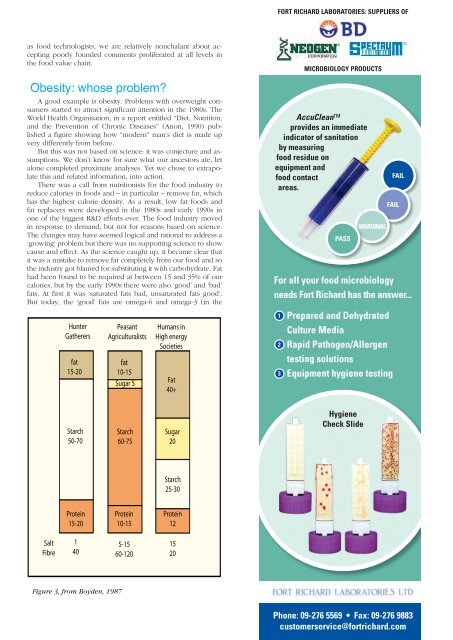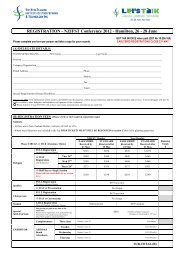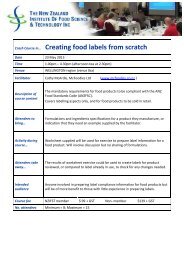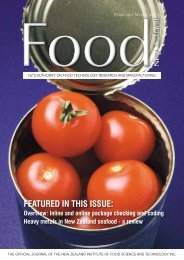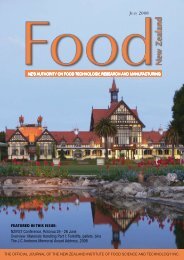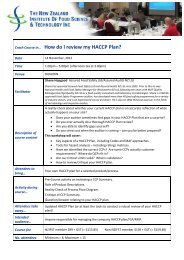JC Andrews Memorial Award 2007baths and no air conditioning, rendering it even hotter than thesurroundings. So I worked during summer from dusk to dawn,when it was cooler. At one <strong>of</strong> my first meetings with Owen, hegave me a final draft copy <strong>of</strong> his first food chemistry book andasked me to pro<strong>of</strong>read it. This experience, along with the engineeringmethods for freezing and refrigerated storage espousedby Dick Earle, combined to drive my pr<strong>of</strong>essional interest infrozen food systems and the complexities <strong>of</strong> the water state infoods. Owen also encouraged me to become involved in IFTand I became very active. I established the Graduate StudentPaper Competition for IFT which ran for the first time in 1977and continues today.<strong>The</strong> PhD defence<strong>The</strong> formative event that influenced my attitudes and pr<strong>of</strong>essionalperformance, however, was my PhD defence. All mystudent colleagues expected me to pass with ease and planswere laid to meet at the pub for lunch. I had duly provided mysupervisor with a list <strong>of</strong> possible examiners to attend the oralexamination; they were the leading meat science, protein andfood chemists in the University. All 8 turned up, promptly at9am.As you may well know, the conversion <strong>of</strong> live muscle tomeat involves the development <strong>of</strong> rigor mortis, a collection <strong>of</strong>physiological changes including the conversion <strong>of</strong> glycogenthrough glucose to lactic acid, by the process <strong>of</strong> glycolysis. <strong>The</strong>established methodology for following this process involved thedecline in muscle pH until – at rigor mortis – the muscle wasdead and all changes ceased. To measure pH effectively, glycolysishad to be stopped, or pH would continue to decline whilethe sample was being analysed and thus give a false result. <strong>The</strong>Training supports andcareer OpportunitiesNZITO specialises in applied learningand development services in meat,dairy, and food processing. Ourspeciality in process operations,labs, boiler operations, transportand supply chain, and food safetytraining.NZITO delivers formal qualifications with subsidies. We alsoprovide lean manufacturing programs to companies to help boostproductivity, reduce waste, lower inventory, improve quality andstreamline communications within the workforce.NZITO supports career developments like gateway options toschools, plus apprenticeships for 16 to 21 year olds. We alsoworks with polytechnics and universities to deliver diploma anddegree options for advanced skillsneeds.People interested in should look atour website www.nzito.co.nz or callus for information.NZITO Box 488 Hamilton NZstandard method was to homogenise meat in a dilute solution<strong>of</strong> sodium iodoacetate which denatured the proteins, and dulystopped glycolysis. <strong>The</strong> then doyen <strong>of</strong> meat science was Pr<strong>of</strong>essorJames Bendall, who had written some seminal articles onmuscle biochemistry. He asserted that the addition <strong>of</strong> iodoacetateto muscle causes a small alkalisation <strong>of</strong> the sample and thisneeded to be corrected to give the exact pH (Bendall, 1973). Iincluded this statement as part <strong>of</strong> my literature review.I began my defence by briefly outlining what research Ihad done and what it meant. <strong>The</strong> first question came from anoutstanding dairy protein chemist with little knowledge <strong>of</strong> meatscience. He asked me to write down the reaction between iodoacetateand a sulfhydryl group – no problem:RSH−− - ++ ICH2COO→ RSCH2COO+ I + HPuzzled, he asked how therefore the addition <strong>of</strong> iodoacetatecould cause an alkalisation <strong>of</strong> the reaction mixture. I looked atthe equation and replied that “Bendall had said it, so it mustbe right”. In all, I defended Bendall for a full 30 minutes, butnot one <strong>of</strong> those examiners let me get away with it. <strong>The</strong> rightanswer was obvious and I refused to accept it, because thesaintly Bendall could not be wrong. <strong>The</strong> examiners continuedto pick up other statements attributed to Bendall and also gaveme a rigorous challenge <strong>of</strong> my research and the conclusions Ihad reached. It was an awesome six hours grilling, one <strong>of</strong> thelongest thesis defences at Wisconsin. I missed the lunch at thepub but joined the troops in the evening with my degree dulygranted. <strong>The</strong> lessons I learnt? Always challenge the givens andbe a sceptic. Always ask for the scientific evidence. Revenge – and a lesson learnedSoon after returning to <strong>New</strong> <strong>Zealand</strong> to work at the MeatIndustry Research <strong>Institute</strong> in Hamilton, I was asked to reviewan article by none other than James Bendall, entitled “<strong>The</strong> relationshipbetween muscle pH and important biochemical parametersduring the post-mortem changes in mammalian muscle”.With vitriol-loaded pen, my review was longer than his articleand included a detailed commentary on the chemical reactionbetween iodoacetate and muscle proteins. <strong>The</strong> editor <strong>of</strong> thejournal gave my report back to Bendall in little pieces, lest he<strong>of</strong>fend him. Revenge was very satisfying and to my amazementBendall rewrote his article significantly and even undertook aseries <strong>of</strong> experiments to prove (and in some cases disprove) thepoints I had made. In fact, he found, through careful scientificexperimentation, that there was actually no pH shift in the iodoacetatepoisoning <strong>of</strong> muscle (Bendall, 1979). He undertookthe science to justify and sometimes refute statements he hadtaken for granted. This is a reflection <strong>of</strong> an outstanding scientist,prepared to go back and check assumptions and not afraid torepeat experiments and acknowledge a mistake. No wonder heremains one <strong>of</strong> my heroes.<strong>The</strong> modern food industry – are wereally science-based?Thirty years on from my PhD, I see that we are constantlybombarded with information that has never been tested scientifically,with no basis in fact and science principles. <strong>The</strong> tenetsmay make sense, but where is the evidence? I am increasinglyand deeply concerned about dramatic changes perpetrated bythe food industry, on the basis <strong>of</strong> unproved and sometimesdodgy science. While we have serious ethical issues facing us20Food <strong>New</strong> <strong>Zealand</strong>
FORT RICHARD LABORATORIES: SUPPLIERS OFas food technologists, we are relatively nonchalant about acceptingpoorly founded comments proliferated at all levels inthe food value chain.Obesity: whose problem?A good example is obesity. Problems with overweight consumersstarted to attract significant attention in the 1980s. <strong>The</strong>World Health Organisation, in a report entitled “Diet, Nutrition,and the Prevention <strong>of</strong> Chronic Diseases” (Anon, 1990) publisheda figure showing how “modern” man’s diet is made upvery differently from before.But this was not based on science: it was conjecture and assumptions.We don’t know for sure what our ancestors ate, letalone completed proximate analyses. Yet we chose to extrapolatethis and related information, into action.<strong>The</strong>re was a call from nutritionists for the food industry toreduce calories in foods and – in particular – remove fat, whichhas the highest calorie density. As a result, low fat foods andfat replacers were developed in the 1980s and early 1990s inone <strong>of</strong> the biggest R&D efforts ever. <strong>The</strong> food industry movedin response to demand, but not for reasons based on science.<strong>The</strong> changes may have seemed logical and rational to address a‘growing’ problem but there was no supporting science to showcause and effect. As the science caught up, it became clear thatit was a mistake to remove fat completely from our food and sothe industry got blamed for substituting it with carbohydrate. Fathad been found to be required at between 15 and 35% <strong>of</strong> ourcalories, but by the early 1990s there were also ‘good’ and ‘bad’fats. At first it was ‘saturated fats bad, unsaturated fats good’.But today, the ‘good’ fats are omega-6 and omega-3 (in theHunterGatherersfat15-20PeasantAgriculturalistsfat10-15Sugar 5Humans inHigh energySocietiesFat40+AccuCleanprovides an immediateindicator <strong>of</strong> sanitationby measuringfood residue onequipment andfood contactareas.For all your food microbiologyneeds Fort Richard has the answer...123MICROBIOLOGY PRODUCTSPASSMARG<strong>IN</strong>ALPrepared and DehydratedCulture MediaRapid Pathogen/Allergentesting solutionsEquipment hygiene testingFAILFAILStarch50-70Starch60-75Sugar20HygieneCheck SlideStarch25-30Protein15-20Protein10-15Protein12SaltFibre1405-1560-1201520Figure 3, from Boyden, 1987Phone: 09-276 5569 • Fax: 09-276 9883customerservice@fortrichard.comJuly 200721


